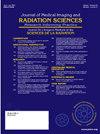Virtual reality for MRI preparation: Participant perceptions from a feasibility study
IF 1.3
Q3 RADIOLOGY, NUCLEAR MEDICINE & MEDICAL IMAGING
Journal of Medical Imaging and Radiation Sciences
Pub Date : 2025-03-22
DOI:10.1016/j.jmir.2025.101890
引用次数: 0
Abstract
Introduction
Undergoing a Magnetic Resonance Imaging (MRI) procedure remains a source of fear and concern for many. Providing adequate information beforehand is essential to ease concerns, yet traditional methods have limitations, often hindered by time constraints. The aim of this study is to explore the acceptability of a Virtual Experience (VE) as an alternative method to prepare patients, with a focus on participant feedback to inform future development.
Methods
Feedback metrics and qualitative responses were captured as part of a wider experimental mixed methods feasibility study. Feedback scores were collated and described, whilst qualitative data underwent a process of thematic analysis.
Results
15 participants underwent two exposures to the VE. The majority were female with an average age of 50, and a third having experienced virtual reality before. Feedback obtained supported perception of the VE to have been engaging, safe, and of benefit, with a willingness to use in the future. From the emerging themes, the experience was considered realistic, fostering acceptance and tolerance of the tool with a number of suggestions for improvement made. Participants would prefer use in a clinical setting with staff support, rather than at home, highlighting its potential to build trust with imaging staff away from pressurised scanning lists ahead of an actual scan.
Conclusion
Participants viewed the VE as a valuable preparatory tool, providing a realistic and acceptable means to familiarise themselves with the process. Their feedback highlights areas for improvement and supports its potential use in practice, underscoring the importance of the public's role in shaping acceptance and future enhancements.
Implications for practice
VR could become a commonplace means of patient preparation and help facilitate coping strategies before an actual scan.
MRI准备的虚拟现实:可行性研究的参与者感知
对许多人来说,接受磁共振成像(MRI)手术仍然是恐惧和担忧的来源。事先提供足够的信息对于缓解担忧至关重要,然而传统方法有局限性,常常受到时间限制的阻碍。本研究的目的是探讨虚拟体验(VE)作为一种替代方法的可接受性,为患者做好准备,重点关注参与者的反馈,为未来的发展提供信息。方法反馈指标和定性反应作为更广泛的实验混合方法可行性研究的一部分。对反馈分数进行整理和描述,同时对定性数据进行专题分析。结果15名参与者接受了两次VE暴露。其中大多数是平均年龄为50岁的女性,三分之一的人之前体验过虚拟现实。反馈得到了对虚拟现实的支持,认为虚拟现实是有吸引力的、安全的、有益的,并且愿意在未来使用。从新出现的主题来看,经验被认为是现实的,促进了对该工具的接受和容忍,并提出了一些改进建议。参与者更愿意在有工作人员支持的临床环境中使用,而不是在家里使用,这突出了它在实际扫描之前与成像人员建立信任的潜力,远离了压力扫描列表。结论:参与者认为VE是一种有价值的准备工具,提供了一种现实和可接受的方法来熟悉过程。他们的反馈强调了需要改进的领域,并支持其在实践中的潜在使用,强调了公众在形成接受度和未来增强方面的作用的重要性。在实际扫描之前,evr可能成为一种常见的患者准备手段,并有助于促进应对策略。
本文章由计算机程序翻译,如有差异,请以英文原文为准。
求助全文
约1分钟内获得全文
求助全文
来源期刊

Journal of Medical Imaging and Radiation Sciences
RADIOLOGY, NUCLEAR MEDICINE & MEDICAL IMAGING-
CiteScore
2.30
自引率
11.10%
发文量
231
审稿时长
53 days
期刊介绍:
Journal of Medical Imaging and Radiation Sciences is the official peer-reviewed journal of the Canadian Association of Medical Radiation Technologists. This journal is published four times a year and is circulated to approximately 11,000 medical radiation technologists, libraries and radiology departments throughout Canada, the United States and overseas. The Journal publishes articles on recent research, new technology and techniques, professional practices, technologists viewpoints as well as relevant book reviews.
 求助内容:
求助内容: 应助结果提醒方式:
应助结果提醒方式:


